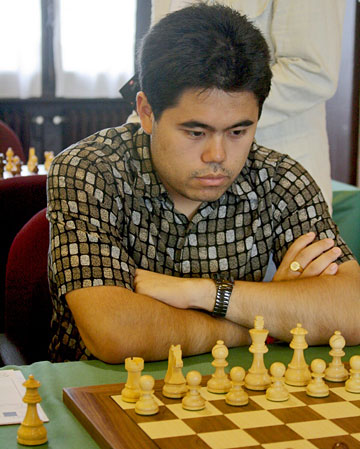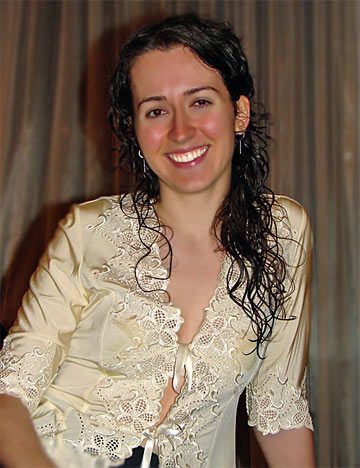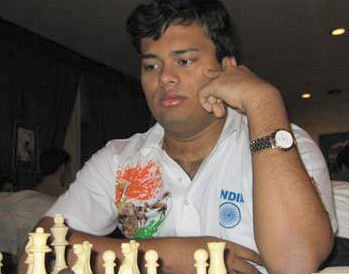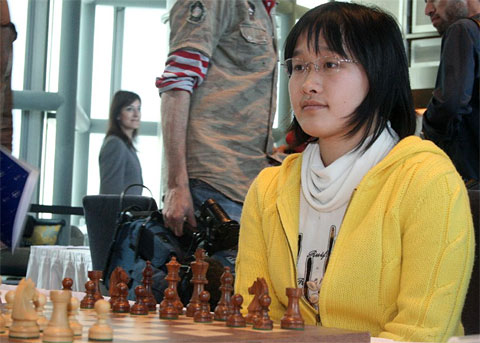| Latest | Greatest | Lobby | Journals | Search | Options | Help | Login |
|
|
|
This topic is archived. |
| Home » Discuss » Topic Forums » Sports |
|
| Jack Rabbit
|
Sun Jul-19-09 06:16 PM Original message |
| The JR Chess Report (July 19): Nakamura is the Pride of the Yankees |
|
Nakamura Wins Donostia-San Sebastián after Blitz Playoff
 Reigning US champion Hikaru Nakamura defeated resurgent Ukrainian GM Ruslan Ponomariov in a two-game blitz playoff Thursday to win the grandmaster tournament in San Sebastián (Donostia in Basque). Nakamura won four of his first five game to open up a one-point lead on the field, but settled for draws in each of the remaining four rounds. Meanwhile, Ponomariov won two of his last three games, including his last round game against Spanish GM Paco Vallejo, to catch Nakamura with 6½ points. The playoff began minutes after the completion of the final round. Nakamura, a premiere blitz player, won both games. Reigning Russian champion Peter Svidler took third prize with 5½ points. For Nakamura, the victory is the latest streamer in a banner year. He finished second in Gibraltar in February, won the US Championship in St. Louis in May, tied for first in the World Open in Philadelphia over the Fourth of July weekend and now is the winner of the category 18 tournament in San Sebastián. His Elo rating has climbed unofficially to 2730, making him the 17th ranked chess master in the world and surpassing Gata Kamsky as the ranking American player and also passing Cuban GM Leinier Domínguez as the number one player in the western hemisphere. San Sebastián, the site of two historic tournaments in the early twentieth century, is located in the Basque region of Spain in the far northeast of the country, near where the Franco-Spanish frontier meets the Bay of Biscay. Bluvshtein and Porper win Canadian Open  Nine players started today's final round of the Canadian Open in Edmonton, Alberta, in first place with 6½ points each, but when the day was finshed two Canadians, Mark Bluvshtein and Edward Porper, shared the top honors. The nine players who started today in first place after eight rounds were, in addition to Bluvshtein and Porper: Alexei Shirov of Spain, the tournament's top seed; Eugene Perelshteyn of the United States; Mickey Adams of England; Irina Krush of the United States; Jonathan Tayer of Canada; Surya Shekhar Ganguly of India; and Theo Hammeles of Holland. Bluvshtein, playing Black, defeated Hammeles in 50 moves while Porper, a mere international master, defeated Ganguly, a strong Indian grandmaster. All other games involving first place contestants today ended in draws. In addition to Porper, several other players who started the day in first where not grandmasters. Ms. Krush is also an IM while Hammeles and Tayer are federation masters. 42nd Biel Chess Festival Opens; Moro Draws First Blood  The 42nd annual Biel Chess Festival began today in Switzerland with Alexander Morozevich defeating defending champion Evgeny Alekseev in the first round of the grandmaster tournament. The grandmaster tournament is a double round robin amoung six players (ten rounds altogether). In other action today in the grandmaster tournament Boris Gelfand of Israel, this year's top seed, drew with Italian national champion Fabiano Caruana and reigning French champion Maxime Vachier Lagrave drew with Ukrainian GM Vassily Ivanchuk. An 11-round open tournament begins tomorrow as part of the event. Calendar Pan-American Continental Championship, São Paulo 25 July-2 August. Mainz Chess Classic 27 July-2 August. US Open, Indianapolis 1-9 August. FIDE Grand Prix, Yerevan 8-24 August. Howard Staunton Memorial, London 8-17 August. Played at historic Simpson's Divan. International Festival d'échecs, Montreal 27 August-7 September. Grandmaster Tournament will include Bacrot, Onischuk, Shulman, Naiditsch and Maze; more to be added. Grand Slam Final, Bilbao 2-15 September. Topalov, Karjakin, Grischuk and Shirov qualify. Second Pearl Spring Tournament, Nanjing 27 September-9 October. Topalov, Anand, Carlsen, Radjabov, Jakovenko and Wang Yue. World Junior Championship, Mar del Plata (Argentina) 16-29 October. European Club Cup (Team Championship), Novi Sad (Serbia) 21-31 October. World Cup, Khanty Mansiysk 28 November-15 December. London Chess Classic 7-16 December. Corus Chess Tournament, Wijk aan Zee 15-31 January 2010. Nakamura has been invited to play in group A. Anand-Topalov Match for the World Title, Site TBA c. April 2010. |
| Printer Friendly | Permalink | | Top |
| Jack Rabbit
|
Sun Jul-19-09 06:56 PM Response to Original message |
| 1. This week's games |
|
Your humble hare acknowledges the assistance of Fritz 6.0 on analysis. Diagrams on the Jack Rabbit Chess Report are made with Chess Mérida, a true type font that can be downlaoded free here. !""""""""# $tMvWlVmT% $OoOoOoOo% $ + + + +% $+ + + + % $ + + + +% $+ + + + % $pPpPpPpP% $RnBqKbNr% /(((((((() WHITE White to move (This position is a theoretical draw) |
| Printer Friendly | Permalink | | Top |
| Jack Rabbit
|
Sun Jul-19-09 06:59 PM Response to Reply #1 |
| 2. Donostia Chess Festival, San Sebastián |
| Printer Friendly | Permalink | | Top |
| Jack Rabbit
|
Sun Jul-19-09 07:01 PM Response to Reply #2 |
| 4. San Segundo - Nakamura, Round 5 |
|
Edited on Sun Jul-19-09 07:13 PM by Jack Rabbit
 Hikaru Nakamura Pablo San Segundo - Hikaru Nakamura Donostia Chess Festival, Round 5 San Sebastián, 12 July 2009 Petit Orthodox Queen's Gambit: Cambridge Springs Defense 1.d4 d5 2.c4 e6 3.Nf3 Nf6 4.Nc3 c6 5.Bg5 Nbd7 6.e3 Qa5
7.cxd5
7...Nxd5 8.Qd2 Bb4 9.Rc1 e5
10.a3 Bxc3
11.bxc3 h6!?
12.Bh4
12...Qxa3 13.Bd3!?
13...exd4 14.cxd4 Qb4 15.Bg3
15...0-0 16.0-0 a5 17.Ra1
17...a4 18.Qc2 Qa5 19.Bd6 Rd8 20.Rfb1
20...N7f6 21.Ba3 Qc3 !""""""""# $t+vT +l+% $+o+ +oO % $ +o+ + O% $+ +m+ + % $o+ P + +% $B WbPn+ % $ +q+ PpP% $Rr+ + K % /(((((((() WHITE: Pablo San Segundo Position after 21...Qa5c3 22.Qxc3!?
22...Nxc3 23.Rc1 Nb5 24.Bxb5 cxb5
25.Rab1 Bd7
26.Ne5 Be8 27.f3!?
!""""""""# $t+ Tv+l+% $+o+ +oO % $ + + M O% $+o+ N + % $o+ P + +% $B + Pp+ % $ + + +pP% $+rR + K % /(((((((() WHITE: Pablo San Segundo Position after 27.f2f3 27...Nd5!
28.Kf2 f6 29.Nd3 Nb6
30.Rc7 Nd5!?
31.Rc2
31...Rac8 32.Rbc1 Rc4 33.Ke2
33...Nb6 34.Nb2 Rxc2+ 35.Rxc2 Bg6!?
!""""""""# $ + T +l+% $+o+ + O % $ M + OvO% $+o+ + + % $p+ P + +% $B + Pp+ % $ Nr+k+pP% $+ + + + % /(((((((() WHITE: Pablo San Segundo Position after 35...Be8g6 36.e4!
36...f5 37.Rc5 fxe4 38.Rxb5 Nd5 39.Rxb7
39...Rc8 40.Bc5 Nf4+!?
41.Ke3 Nd5+ 42.Ke2 Ra8 43.Nc4
43...Nf4+ 44.Kd2
44...Nxg2 45.fxe4 Bxe4 46.Re7 Bc6 47.Bd6?
47...Nh4 48.Kc3
!""""""""# $t+ + +l+% $+ + R O % $ +vB + O% $+ + + + % $o+nP + M% $+ K + + % $ + + + P% $+ + + + % /(((((((() WHITE: Pablo San Segundo Position after 48.Kd2c3 48...Nf5!
49.Re1
49...Nxd6 50.Nxd6 a3 51.Nc4
51...a2 52.Ra1 Bd5 53.Nb6 Ra3+ 54.Kd2 Bf7 0-1
|
| Printer Friendly | Permalink | | Top |
| Jack Rabbit
|
Sun Jul-19-09 07:02 PM Response to Reply #2 |
| 5. Ponomariov - Vachier Lagrave, Round 7 |
|
Edited on Sun Jul-19-09 07:03 PM by Jack Rabbit
 Ruslan Ponomariov Ruslan Ponomariov - Maxime Vachier Lagrave Donostia Chess Festival, Round 7 San Sebastián, 14 July 2009 West India Game: Indian Queen's Gambit (Exchange Opening) (Grünfeld Defense) 1.d4 Nf6 2.c4 g6 3.Nc3 d5 4.cxd5
4...Nxd5 5.e4 Nxc3 6.bxc3 Bg7 7.Bc4
7...c5 8.Ne2 Nc6 9.Be3 0-0 10.0-0 Bd7
11.Rb1 Qc7
12.Bd3
12...Rad8 13.Qc1
13...Bc8 14.Rd1 b6
15.h3 Bb7?!
!""""""""# $ + T Tl+% $OvW OoVo% $ Om+ +o+% $+ O + + % $ + Pp+ +% $+ PbB +p% $p+ +nPp+% $+rQr+ K % /(((((((() WHITE: Ruslan Ponomariov Position after 15...Bc8b7 16.dxc5!?
16...bxc5 17.Qa3 Na5 18.f3!
18...c4
19.Bc2 Rxd1+ 20.Rxd1 Be5
21.Qc5 Nc6 22.Qxc4 Rc8 23.Bb3 e6 24.Qc5 Ba6
25.Nd4 Nxd4?
!""""""""# $ +t+ +l+% $O W +o+o% $v+ +o+o+% $+ Q V + % $ + Mp+ +% $+bP Bp+p% $p+ + +p+% $+ +r+ K % /(((((((() WHITE: Ruslan Ponomariov Position after 25...Nc6d4:N 26.cxd4!
26...Bf4
27.Bxf4
27...Qxf4 28.Qa5 Qe3+ 29.Kh2 Bc4
30.Bxc4 Rxc4 31.Qe5
31...Rb4 32.d5 Qc5 33.Qf6 exd5 34.exd5 1-0
|
| Printer Friendly | Permalink | | Top |
| Jack Rabbit
|
Sun Jul-19-09 07:00 PM Response to Reply #1 |
| 3. Canadian Open, Edmonton |
| Printer Friendly | Permalink | | Top |
| Jack Rabbit
|
Sun Jul-19-09 07:04 PM Response to Reply #3 |
| 6. Shirov - Ganguly, Round 7 |
 Alexei Shirov Alexei Shirov - Surya Shekhar Ganguly Canadian Open, Round 7 Edmonton, 17 July 2009 Closed French Game: Nimzovich Defense (Winawer Defense) 1.e4 e6 2.d4 d5 3.Nc3 Bb4 4.e5 c5 5.a3
5...Bxc3+ 6.bxc3 Ne7 7.Qg4
7...Qc7
8.Qxg7 Rg8 9.Qxh7 cxd4 10.Ne2 Nbc6 11.f4 Bd7 12.Qd3 dxc3 13.Qxc3
13...0-0-0 14.Rb1 Nf5 15.Rg1 d4 16.Qd3 Na5
17.Rb4
17...Nc6?
!""""""""# $ +lT +t+% $OoWv+o+ % $ +m+o+ +% $+ + Pm+ % $ R O P +% $P +q+ + % $ +p+n+pP% $+ B KbR % /(((((((() WHITE: Alexei Shirov Position after 17...Na5c6 18.Rc4!
18...Be8
19.g4 Nh4 20.Rg3
20...f6
21.exf6 Bg6 22.Rxc6
22...Qxc6 23.Nxd4 Qh1
24.f5 exf5 25.Bf4!
25...Be8 26.Qc4+ Bc6 27.Qe6+ Bd7 28.Rc3+ 1-0
|
| Printer Friendly | Permalink | | Top |
| Jack Rabbit
|
Sun Jul-19-09 07:06 PM Response to Reply #3 |
| 7. Zilberman - Krush, Round 8 |
 Irina Krush Dmitry Zilberstein - Irina Krush Canadian Open, Round 8 Edmonton, 18 July 2009 West India Game: King's Indian Defense (Aronin Opening) 1.d4 Nf6 2.c4 g6 3.Nc3 Bg7 4.e4 d6 5.Nf3 0-0 6.Be2 e5 7.Be3 Nbd7
8.0-0
8...Re8
9.Qc2
9...exd4 10.Nxd4 c6 11.Rad1 a6
12.Bg5!?
12...Qc7
13.Rd2?
13...b5 14.cxb5 cxb5 15.a3
15...Bb7 16.f3 !""""""""# $t+ +t+l+% $+vWm+oVo% $o+ O Mo+% $+o+ + B % $ + Np+ +% $P N +p+ % $ PqRb+pP% $+ + +rK % /(((((((() WHITE: Dmitry Zilberstein Position after 16.f2f3 16...d5!
17.exd5 Nxd5 18.Kh1
18...Nxc3 19.bxc3
19...Nb6 20.Bd3 !""""""""# $t+ +t+l+% $+vW +oVo% $oM + +o+% $+o+ + B % $ + N + +% $P Pb+p+ % $ +qR +pP% $+ + +r+k% /(((((((() WHITE: Dmitry Zilberstein Position after 20.Be2d3 20...Qc5!
21.h4
21...Qxa3 22.Ne2
22...Rac8 23.Qb1 Qc5 24.Rc1 Nc4 25.Ra2
25...h6 26.Bf4
26...Rcd8 27.Ng3 g5 28.hxg5
28...hxg5 29.Bd2 Re6 30.Nf5
30...Nxd2 31.Rxd2 Rdd6 32.Nd4 Rh6+ 33.Kg1 Bxd4+
34.cxd4 Qxd4+ 35.Kf1
35...Qe3 0-1
|
| Printer Friendly | Permalink | | Top |
| Jack Rabbit
|
Sun Jul-19-09 07:07 PM Response to Reply #3 |
| 8. Ganguly - Hommeles, Round 6 |
|
Edited on Sun Jul-19-09 07:07 PM by Jack Rabbit
 Surya Shekhar Ganguly Surya Shekhar Ganguly - Theo Hommeles Canadian Open, Round 6 Edmonton, 16 July 2009 Open Sicilian Game: Najdorf-Scheveningen Defense (Rauzer Opening) 1.e4 c5 2.Nf3 d6 3.d4 cxd4 4.Nxd4 Nf6 5.Nc3 Nc6 6.Bg5 e6 7.Qd2 a6 8.0-0-0 Bd7
9.f3
9...Rc8
10.Kb1 Be7 11.Nxc6
11...Bxc6 12.h4 Qc7
13.Bf4 Rd8 14.g4 h6!?
15.Qf2
15...b5 16.Bg2 Nd7 17.g5
17...hxg5 18.hxg5 Rxh1 19.Bxh1
19...Rc8 20.Qd2 Ne5
21.Ne2 Bb7 22.b3!?
22...g6
23.Bg2 Bf8 24.Be3 d5 25.Bd4 Rd8
!""""""""# $ + TlV +% $+vW +o+ % $o+ +o+o+% $+o+oM P % $ + Bp+ +% $+p+ +p+ % $p+pQn+b+% $+k+r+ + % /(((((((() WHITE: Surya Sekhar Ganguly Position after 25...Rc8d8 26.Qc3!?
26...Qxc3 27.Nxc3
27...Nc6?!
28.Bb6! Rc8? 29.exd5 Nb4
!""""""""# $ +t+lV +% $+v+ +o+ % $oB +o+o+% $+o+p+ P % $ M + + +% $+pN +p+ % $p+p+ +b+% $+k+r+ + % /(((((((() WHITE: Surya Sekhar Ganguly Position after 29...Nc6b4 30.d6!!
30...Bxd6
31.Rxd6 Rxc3 32.Ba5!
32...Rxc2 33.Rd8+ 1-0
|
| Printer Friendly | Permalink | | Top |
| Jack Rabbit
|
Sun Jul-19-09 07:08 PM Response to Reply #3 |
| 9. Zhao Xue - Mackinnon, Round 6 |
 Zhao Xue Zhao Xue - Kieth Mackinnon Canadian Open, Round 6 Edmonton, 16 July 2009 West India Game: Tal-Indian Defense (Benko Gambit) 1.d4 Nf6 2.c4 c5 3.d5 b5 4.cxb5 a6 5.bxa6 g6 6.Nc3 Bxa6 7.Nf3 d6 8.g3
8...Bg7 9.Bg2 Nbd7 10.Rb1 Qa5 11.Bd2 0-0 12.0-0 Nb6
13.b3 Qa3
14.Ne1 Bb7 15.Nc2 Qa6 16.e4 Ne8
17.Re1 Nc7 18.a4 e6
!""""""""# $t+ + Tl+% $+VM +oVo% $wM Oo+o+% $+ Op+ + % $p+ +p+ +% $+pN + P % $ +nB PbP% $+r+qR K % /(((((((() WHITE: Zhao Xue Position after 18...e7e6 19.Ne3!
19...exd5?
20.Ncxd5 Ncxd5 21.exd5 Qd3
22.Rc1!
22...Rfe8
23.Bc3 Qxd1 24.Rexd1! !""""""""# $t+ +t+l+% $+v+ +oVo% $ M O +o+% $+ Op+ + % $p+ + + +% $+pB N P % $ + + PbP% $+ Rr+ K % /(((((((() WHITE: Zhao Xue Position after 24.Re1d1:Q
24...Bxc3 25.Rxc3 Ra5
26.Bf1
26...Ba6
27.Bxa6 Rxa6 28.f3 Rb8 29.Ra1 Kf8 30.Kf2 Ke7 31.g4
31...h6 32.h4 Kd7
!""""""""# $ T + + +% $+ +l+o+ % $tM O +oO% $+ Op+ + % $p+ + +pP% $+pR Np+ % $ + + K +% $R + + + % /(((((((() WHITE: Zhao Xue Position after 32...Ke7d7 33.f4 c4
34.a5 cxb3 35.Rxb3 Rba8 36.Re1 Nc8 37.Rb7+ 1-0
|
| Printer Friendly | Permalink | | Top |
| Jack Rabbit
|
Sun Jul-19-09 07:45 PM Response to Original message |
| 10. Cool Chess Set |
 Black  White Name: Alice in wonderland chess set number 8 of 1st edition Code: Alice chess set The price, according to the blurb at the link, is $10,000. Start saving now, especially if your wife likes all things Lewis Carroll and you yourself don't know the right name for the city that is the jewel of the Pacific Coast. |
| Printer Friendly | Permalink | | Top |
| Condem
|
Sun Jul-19-09 09:19 PM Response to Original message |
| 11. Hey, Jack Rabbit |
|
What happened to the baseball scores. I miss them.
|
| Printer Friendly | Permalink | | Top |
| Jack Rabbit
|
Sun Jul-19-09 09:32 PM Response to Reply #11 |
| 12. OK, I'll go back to doing those tomorrow |
|
Thank you for the popular demand.
|
| Printer Friendly | Permalink | | Top |
| madinmaryland
|
Mon Jul-20-09 09:25 PM Response to Original message |
| 13. Anything happening in the DC area? |
| Printer Friendly | Permalink | | Top |
| Jack Rabbit
|
Tue Jul-21-09 12:40 AM Response to Reply #13 |
| 14. Here's what I can find out . . . |
|
Please click here.
|
| Printer Friendly | Permalink | | Top |
| Jack Rabbit
|
Tue Jul-21-09 03:03 PM Response to Original message |
| 15. Update (Tuesday): 3-way tie half way thru Politiken Cup |
 Peter Heine Nielsen (Denmark)m Vladimir Malakhov (Russia) and Jonny Hector (Sweden) are tied with perfect scores half way through the ten-round Politiken Cup, the annual open tournament taking place in Helsingør, Denmark, as part of the Copenhagen Chess Festival. Nine players are tied for fourth at 4½ points each: Evgeny Agrest (Sweden), Stellan Brynell (Sweden), Viktorija Cmilyte (Lithuania), Alexei Dreev (Russia), Jon Ludwig Hammer (Norway), Tiger Hillarp Persson (Sweden), Parmerian Negi (India), Evgeny Postny (Israel) and Gabriel Sargissian (Armenia). Nearly 300 chess players are taking part in this year's tournament. Helsingør, about 25 miles from Copenhagen, is better known to Shakespeare buffs as Elsinore, the setting of the tragedy Hamlet.  Kronberg Castle, Helsingør (Elsinore) |
| Printer Friendly | Permalink | | Top |
| DU
AdBot (1000+ posts) |
Tue Apr 23rd 2024, 03:43 PM Response to Original message |
| Advertisements [?] |
| Top |
| Home » Discuss » Topic Forums » Sports |
|
Powered by DCForum+ Version 1.1 Copyright 1997-2002 DCScripts.com
Software has been extensively modified by the DU administrators
Important Notices: By participating on this discussion board, visitors agree to abide by the rules outlined on our Rules page. Messages posted on the Democratic Underground Discussion Forums are the opinions of the individuals who post them, and do not necessarily represent the opinions of Democratic Underground, LLC.
Home | Discussion Forums | Journals | Store | Donate
About DU | Contact Us | Privacy Policy
Got a message for Democratic Underground? Click here to send us a message.
© 2001 - 2011 Democratic Underground, LLC